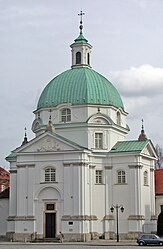Kasimir Church (Warsaw)
| Kasimir Church | |
|---|---|
|
View from the market square |
|
| Construction year: | 1688 |
| Inauguration: | 1692 |
| Style elements : | Baroque |
| Client: | Catholic Church |
| Location: | 52 ° 15 ′ 11 " N , 21 ° 0 ′ 32" E |
| Address: |
Market Square 2 Warsaw Poland |
| Purpose: | Roman Catholic Benedictine Church |
| Diocese : | Warsaw |
The St. Casimir Church in Warsaw ( Polish Kościół św. Kazimierza , also Kościół Sakramentek ) is a Baroque church in the Polish capital. It is located on the New Town Market (Polish: Rynek Nowego Miasta ), in Warsaw New Town (Polish: Nowe Miasto ), a district that begins at the city walls of the old town and extends along the embankment of the Vistula .
The church was created on the basis of a donation from Queen Marie Casimire Louise de la Grange d'Arquien , wife of King John III. Sobieski as the monastery church of the Benedictine Sisters of the Most Holy Sacrament who she invited to Poland .
The building is (besides the Antonius Church in the Czerniaków district ) the only Warsaw baroque church with the central plan of a Greek cross . It was built according to the design of the Dutch architect Tylman van Gameren under the supervision of the royal court architect Agostino Locci the Elder . Construction began in 1688 and lasted until 1692, and the furnishing lasted for almost a century.
Adam Kotowski's residence next to the church , also a work by Tylman van Gameren, was converted into a monastery by the queen.
In 1740 a new monastery building was built according to the design of the Italian architect Antonio Solari, donated by the Radziwiłł family .
The church was built in the shape of an octagonal room with four short arms that formed the arms of the Greek cross . The also octagonal tambour had an octagonal dome, topped with a lantern with a royal crown and cross on top. The facades were structured by Tuscan pilasters , which at the ends of the cross arms support the entablature with tympana . The windows were raised high to make room for altars underneath.
The church survived the siege of Warsaw in 1939 unscathed. During the Warsaw Uprising in 1944, residents gathered in the burnt but not yet collapsed church in the hope that the church would be spared during the air raids. On August 31, at 3 p.m. when the Luftwaffe attacked, aerial bombs hit the dome. The debris buried about 1,000 civilians, including wounded and nuns.
The damage covered 80 percent of the building fabric. With the help of the surviving designs from van Gameren and the surveying drawings of the architecture students 1925–1933, the reconstruction began. The architect Maria Zachwatowicz created the design in 1945. The reconstruction took place in the years 1948 to 1952.
Only the tomb of Marie Caroline de Bouillon remains from the original interior of the church.
Vedute by Canaletto 1778
The church was registered on July 1, 1965 and March 6, 2007 under A-744 in the list of architectural monuments of the Masovian Voivodeship.
Individual evidence
- ↑ http://www.nid.pl/pl/Informacje_ogolne/Zabytki_w_Polsce/rejestr-zabytkow/zestawienia-zabytkow-nieruchomych/stan%20na%2030.09.13/MAZ-WAR-rej.pdf




